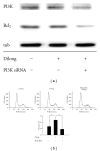RSC96 Schwann Cell Proliferation and Survival Induced by Dilong through PI3K/Akt Signaling Mediated by IGF-I
- PMID: 20040524
- PMCID: PMC3135880
- DOI: 10.1093/ecam/nep216
RSC96 Schwann Cell Proliferation and Survival Induced by Dilong through PI3K/Akt Signaling Mediated by IGF-I
Abstract
Schwann cell proliferation is critical for the regeneration of injured nerves. Dilongs are widely used in Chinese herbal medicine to remove stasis and stimulate wound-healing functions. Exactly how this Chinese herbal medicine promotes tissue survival remains unclear. The aim of the present study was to investigate the molecular mechanisms by which Dilong promote neuron regeneration. Our results show that treatment with extract of Dilong induces the phosphorylation of the insulin-like growth factor-I (IGF-I)-mediated phosphatidylinositol 3-kinase/serine-threonine kinase (PI3K/Akt) pathway, and activates protein expression of cell nuclear antigen (PCNA) in a time-dependent manner. Cell cycle analysis showed that G(1) transits into the S phase in 12-16 h, and S transits into the G(2) phase 20 h after exposure to earthworm extract. Strong expression of cyclin D1, cyclin E and cyclin A occurs in a time-dependent manner. Small interfering RNA (siRNA)-mediated knockdown of PI3K significantly reduced PI3K protein expression levels, resulting in Bcl(2) survival factor reduction and a marked blockage of G(1) to S transition in proliferating cells. These results demonstrate that Dilong promotes the proliferation and survival of RSC96 cells via IGF-I signaling. The mechanism is mainly dependent on the PI3K protein.
Figures





Similar articles
-
Dilong: role in peripheral nerve regeneration.Evid Based Complement Alternat Med. 2011;2011:380809. doi: 10.1093/ecam/neq079. Epub 2011 Jun 15. Evid Based Complement Alternat Med. 2011. PMID: 21799677 Free PMC article.
-
Nerve Regeneration Potential of Protocatechuic Acid in RSC96 Schwann Cells by Induction of Cellular Proliferation and Migration through IGF-IR-PI3K-Akt Signaling.Chin J Physiol. 2015 Dec 31;58(6):412-9. doi: 10.4077/CJP.2015.BAD340. Chin J Physiol. 2015. PMID: 26717920
-
Alpinia oxyphylla Miq. fruit extract activates IGFR-PI3K/Akt signaling to induce Schwann cell proliferation and sciatic nerve regeneration.BMC Complement Altern Med. 2017 Mar 31;17(1):184. doi: 10.1186/s12906-017-1695-2. BMC Complement Altern Med. 2017. PMID: 28359314 Free PMC article.
-
Dilong prevents the high-KCl cardioplegic solution administration-induced apoptosis in H9c2 cardiomyoblast cells mediated by MEK.Am J Chin Med. 2014;42(6):1507-19. doi: 10.1142/S0192415X14500943. Am J Chin Med. 2014. PMID: 25482676
-
Schwann Cell Migration Induced by Earthworm Extract via Activation of PAs and MMP2/9 Mediated through ERK1/2 and p38.Evid Based Complement Alternat Med. 2011;2011:395458. doi: 10.1093/ecam/nep131. Epub 2011 Jan 4. Evid Based Complement Alternat Med. 2011. PMID: 19808845 Free PMC article.
Cited by
-
Pharmacological effects of bioactive agents in earthworm extract: A comprehensive review.Animal Model Exp Med. 2024 Oct;7(5):653-672. doi: 10.1002/ame2.12465. Epub 2024 Jul 3. Animal Model Exp Med. 2024. PMID: 38957072 Free PMC article. Review.
-
Neuroprotective effects of Buyang Huanwu decoction on cerebral ischemia-induced neuronal damage.Neural Regen Res. 2014 Sep 1;9(17):1621-7. doi: 10.4103/1673-5374.141791. Neural Regen Res. 2014. PMID: 25368650 Free PMC article.
-
Earthworm (Pheretima aspergillum) extract stimulates osteoblast activity and inhibits osteoclast differentiation.BMC Complement Altern Med. 2014 Nov 11;14:440. doi: 10.1186/1472-6882-14-440. BMC Complement Altern Med. 2014. PMID: 25387689 Free PMC article.
-
Dilong: role in peripheral nerve regeneration.Evid Based Complement Alternat Med. 2011;2011:380809. doi: 10.1093/ecam/neq079. Epub 2011 Jun 15. Evid Based Complement Alternat Med. 2011. PMID: 21799677 Free PMC article.
-
The Proliferation Enhancing Effects of Salidroside on Schwann Cells In Vitro.Evid Based Complement Alternat Med. 2017;2017:4673289. doi: 10.1155/2017/4673289. Epub 2017 Jun 7. Evid Based Complement Alternat Med. 2017. Retraction in: Evid Based Complement Alternat Med. 2025 Apr 24;2025:9857212. doi: 10.1155/ecam/9857212. PMID: 28680451 Free PMC article. Retracted.
References
-
- Bunge RP. Expanding roles for the Schwann cell: ensheathment, myelination, trophism and regeneration. Current Opinion in Neurobiology. 1993;3(5):805–809. - PubMed
-
- Fawcett JW, Keynes RJ. Peripheral nerve regeneration. Annual Review of Neuroscience. 1990;13:43–60. - PubMed
-
- Bunge RP. The role of the Schwann cell in trophic support and regeneration. Journal of Neurology. 1994;242(1, supplement):S19–S21. - PubMed
-
- Schumacher M, Jung-Testas I, Robel P, Baulieu EE. Insulin-like growth factor I: a mitogen for rat Schwann cells in the presence of elevated levels of cyclic AMP. Glia. 1993;8(4):232–240. - PubMed
-
- Le Roith D, Butler AA. Insulin-like growth factors in pediatric health and disease. Journal of Clinical Endocrinology and Metabolism. 1999;84(12):4355–4361. - PubMed
LinkOut - more resources
Full Text Sources
Research Materials
Miscellaneous

